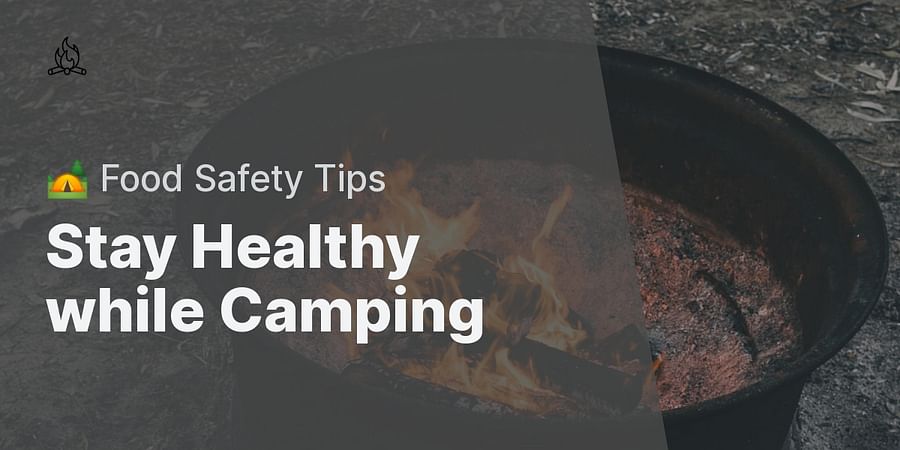Important Camping Food Safety Tips to Keep You and Your Family Healthy

Imagine this: You're nestled deep in the heart of bear country, the crackling campfire casting long shadows as you prepare a hearty meal under the star-studded sky. Sounds idyllic, doesn't it? But, did you know that this picturesque scene can quickly turn into a health hazard if camping food safety tips are not diligently followed?
From selecting the right high energy hiking foods, to proper food storage in bear country, to whipping up one-pot vegan camping recipes – there's a lot to consider. Why, you ask? Well, foodborne illnesses can transform your dream camping adventure into a nightmare, quicker than a squirrel can swipe your trail mix!
But fret not, dear camper, for we have the ultimate guide to help you navigate through the wilderness of camping meal planning. Ready to embark on a safe culinary adventure? Then let's dive into the world of outdoor food safety, where we'll learn how to keep our meals as fresh as the mountain air, and as clean as the babbling brook nearby.
Remember, a healthy camper is a happy camper. So, let's ensure that your camping memories are filled with fun hikes, cozy campfire tales, and delicious, safe-to-eat meals. Ready to explore?

Imagine setting up camp in a lush forest, the desert's stark beauty, or by a tranquil water body. While the change of scenery is refreshing, it also brings unique challenges to maintaining your camping food safety. Campsites near water bodies, for instance, may harbor more insects, requiring extra vigilance in food storage. In contrast, the dry desert environment could dehydrate your food faster, affecting its quality and safety.
Forest camping, especially in bear country, demands strict adherence to wildlife-friendly food storage practices. Bears have an exceptional sense of smell, and the slightest food aroma could invite unwanted visitors to your campsite. So, how do you ensure your food is safe and doesn't attract wildlife? Our article on food storage in bear country provides detailed guidelines for this.
Planning your meals wisely is another crucial aspect of camping food safety. High-energy hiking foods, healthy camping meals, and easy-to-prepare options like one-pot vegan camping recipes can make a big difference. Curious about what to pack for your next camping trip? Check out our FAQ for some inspiration.
Remember, a successful camping trip isn't just about the right gear or the perfect spot; it's also about ensuring your outdoor food safety practices are up to par. So, are you ready to take on the wild while keeping your meals safe and delicious?
Now that we've discussed how different environments can impact your food safety practices, let's take a closer look at some of these locations. Here's a map that shows various types of camping environments, along with some food safety tips for each. From forests to deserts, to campsites near water bodies, each location presents unique challenges and opportunities for maintaining food safety.
As you can see, each environment requires a different approach to food safety. One common factor in many camping locations, however, is the presence of wildlife. In the next section, we'll discuss how to properly pack and store food in bear-populated areas to prevent attracting these creatures to your campsite.
When it comes to camping in bear country, your food storage strategy is more than just a meal planning consideration - it's a matter of safety. Bears are opportunistic feeders with an excellent sense of smell, and they can be attracted to your campsite by the scent of food from miles away. So, how do you keep your provisions safe?
Firstly, never store food in your tent. This is a golden rule of camping food safety tips. Instead, make use of bear-resistant food containers or hang your food at least 10 feet off the ground and 4 feet away from tree trunks. Check out our FAQ for more detailed guidelines.
But what about the food itself? Opt for less aromatic foods if possible. High energy hiking foods like trail mix, energy bars, and dried fruits are great options. They're not only less likely to attract bears but also provide the nutrition you need for outdoor activities. For more ideas, check out our guide to healthy camping meals.
Remember, proper food storage isn't just about keeping bears away. It's also about maintaining the freshness and safety of your food. So, always pack your food in airtight, waterproof containers and keep it cool to prevent spoilage. Wondering how to keep meat fresh without a fridge while camping? Our FAQ has you covered!

When it comes to embarking on a camping adventure, packing the right food isn't just about taste or convenience—it's about survival. Proper camping meal planning is a fine balance between packing foods that are lightweight, nutritious, and easy to prepare. But how do you ensure you're making the right choices?
First, consider the nature of your activities. Are you planning a leisurely camping trip or an intense hiking expedition? High energy hiking foods, like trail mix and energy bars, are perfect for the latter, providing you with the necessary fuel to conquer the trails. Check out our list of Ultimate Backpacking Meal Ideas for more inspiration.
Secondly, think about the environment. Outdoor food safety varies greatly depending on where you're camping. For instance, food storage in bear country requires special precautions. Curious about how to keep your food—and yourself—safe from wandering bears? Our FAQ has some useful tips.
Finally, consider dietary preferences and restrictions. For our vegan campers, we've got a host of delicious one-pot vegan camping recipes that are both nutritious and easy to prepare. Why not try out our simple and delicious camping meals on your next trip?
Remember, a well-fed camper is a happy camper. So pack wisely, eat heartily, and let the adventure begin!
Now that we've established the importance of campsite kitchen etiquette, let's dive deeper into the nitty-gritty of camping food safety. Ever wondered why your camping meals should never be a game of mix and match? It's simple. Different food types require different handling and storage conditions to prevent cross-contamination and food-borne illnesses.
Think about it. Would you store your high energy hiking foods, your raw meats, and your fresh fruits in the same cooler without any separation? That's a recipe for disaster, not a delicious, nutritious camping meal!
Temperature control is another crucial aspect of outdoor food safety. Just because you're out in the wild doesn't mean your food storage practices should go wild too. Foods like raw meats, dairy products, and prepared meals need to be kept at safe temperatures to prevent the growth of harmful bacteria.
And let's not forget about cleanliness! Your camping meal planning should always include provisions for cleaning utensils, cooking equipment, and your hands. After all, what good are one-pot vegan camping recipes if they're prepared in a pot that's not clean?
Remember, when it comes to camping food safety, it's always better to be safe than sorry. So, are you ready to take your camping food hygiene to the next level?
Water, the lifeblood of any camping expedition, can also be a silent threat if not treated with due respect. In the wilderness, even the clearest streams can harbor invisible dangers. But fear not, fellow campers, for there are multiple ways to ensure your water is as pure as a mountain spring.
Boiling is the old faithful of water purification. It's simple, effective, and requires no special equipment. Just bring the water to a rolling boil for at least one minute and voila, you're good to go. But what if you're running low on fuel or the weather isn't cooperating? That's where portable water filters come in handy. These compact lifesavers can remove over 99% of bacteria and parasites, making your water safe to drink in no time.
Chemical treatments, like iodine or chlorine tablets, can also be effective, especially as a backup option. Just remember to let them work their magic for at least 30 minutes before taking a sip. And for those who prefer a high-tech solution, UV light sterilizers can kill bacteria, viruses, and protozoa in just a few minutes.
Remember, a healthy camper is a happy camper. Don't let contaminated water ruin your outdoor adventure. Stay hydrated and stay safe with these camping food safety tips.

As we dive into the world of camping food safety tips, let's explore the exciting realm of one-pot vegan camping meals. These dishes not only promise a burst of flavor but also ensure food safety and good nutrition. Imagine this: you're nestled in the heart of the wilderness, the campfire crackling, stars twinkling overhead, and a hearty, nutritious meal simmering away in one pot. Sounds idyllic, doesn't it?
But how can we ensure that this picture-perfect scenario also aligns with the best practices for outdoor food safety? And how can we uphold our camping meal planning while ensuring food storage in bear country? Well, with the right knowledge and a sprinkle of creativity, it's easier than you think.
Whether you're a seasoned camper or a first-timer, these healthy camping meals will not only fuel your outdoor adventures but also ensure you're following essential camping food hygiene practices. From high energy hiking foods to simple, delicious one-pot vegan camping recipes, we've got you covered. So, ready to embark on this culinary journey?
Learn more about 🌱 One-Pot Vegan Camping Meals or discover other Camp Diet recipes.
As we reach the end of our culinary expedition, let's take a moment to digest the essence of our journey. Remember the days of reckless sandwich stuffing and loose trail mix in your backpack? Those carefree days are behind us, replaced with a newfound appreciation for camping food safety tips.
We've navigated through the thickets of camping meal planning, learned the significance of food storage in bear country, and discovered the value of high energy hiking foods. We've even dabbled in the art of outdoor food safety and savored the simplicity of one-pot vegan camping recipes.
Now, imagine the rustle of leaves underfoot, the hum of the forest, and a warm fire casting long shadows. Imagine a meal that's not just delicious but also safe and healthy. That's the power of knowledge, the gentle nudge that transforms a simple camping trip into a symphony of experiences.
Will you let delicious meals be the melody of your next camping trip? Or will you let the harmony of flavorful vegan recipes guide you? Perhaps the rhythm of safe food storage practices will set your pace? The choice, dear camper, is yours to make.
Remember, each camping trip is a new verse in your song of exploration. So, gear up, prepare well, and let's keep our forests singing.
Test your knowledge on camping food safety practices. Choose the best answer for each question.
Learn more about 🔍 Test Your Knowledge: Camping Food Safety Quiz or discover other Camp Diet quizzes.
Post a comment